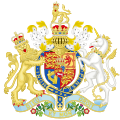Alienation Office facts for kids
| Agency overview | |
|---|---|
| Formed | 1576 |
| Dissolved | 1835 |
| Jurisdiction | England and Wales |
| Agency executives |
|

The Alienation Office was an old British government office. It was in charge of controlling the 'alienation' or transfer of certain lands in England. This happened during a time called the feudal era. People needed a special licence to alienate (permission) from the king to transfer land. Later, the government continued this system.
Contents
What Was the Alienation Office?
The Alienation Office made sure that land transfers followed the rules. It was active from 1576 until 1835. This office was important for how land was owned and passed on in England.
Why Was This Office Needed?
In the past, the king was seen as the true owner of all land. Other people only "held" land from him. This system was called feudalism. Important landowners, called tenants-in-chief, held land directly from the king. They were a big part of the king's army.
When King William the Conqueror took over England, he gave land to his main military leaders. The idea was that each piece of land, called a "fee," would support one knight. This knight would then serve the king in battle. The king wanted to make sure that any new person taking over a fee would be a good soldier. So, a licence to alienate was like the king's way of saying yes or no to a new landowner.
When Did It Start?
The first rules for controlling land transfers began a long time ago. This was during the reign of King Henry III (1216–1272). He made a rule that his main landowners could not transfer their land without his special permission.
Penalties for Not Following Rules
At first, if someone transferred land without the king's permission, they could lose their land. This was called forfeiture. Later, in 1327, the punishment changed. Instead of losing the land, people had to pay a fine. This fine went into a special fund called the Hanaper of the Chancery.
Over time, the system became more settled. If you transferred land without a royal licence, the fine was equal to one year's income from that land. To get a licence, you had to pay one-third of the land's value.
How the Alienation Office Was Set Up
The Alienation Office was properly created in 1576. Robert Dudley, 1st Earl of Leicester, was given the right to collect the money from these land transfer licences for ten years. This also included payments made during court hearings. The office grew from the system Dudley put in place.
Even after Dudley died in 1588, his system continued. The office was located in London, where many legal offices are today.
Changes Over Time
During the Commonwealth period (1649–1660), the office stopped for a short time. It was closed in 1653 but brought back a year later. This happened when people realized how much money the government was losing.
A big change happened in 1661. The old feudal system of land ownership was mostly ended. This meant that the idea of a "tenant-in-chief" was removed from English law. Rules that limited the free transfer of land were also removed.
However, the Alienation Office still continued for almost 200 more years! After the Glorious Revolution of 1688, King William III and Queen Mary II took control. In 1689, the Commissioners of the Treasury started to oversee the office.
In 1758, the office's duties grew a little. It started to handle certain fines directly. By the end of the 1700s, the British Parliament looked closely at how the office worked and how it was funded.
The End of the Office
In the 1830s, many reforms happened in the United Kingdom. The Alienation Office did not survive these changes. In 1834, land transfer laws were updated. The old system of fines and recoveries was abolished. This meant the Alienation Office no longer had a main job. So, it was officially closed in 1835.
Important People: Receivers-General
| Receiver-General of Alienation Office | |
|---|---|

|
|
| Appointer | Monarch of England (1603–1707) Monarch of Great Britain (1707-1801) Monarch of the United Kingdom (1801–1832) |
| Term length | At the Monarch's pleasure |
| Formation | 1603 |
| First holder | Sir Arthur Atys |
| Final holder | Charles Dodd |
| Abolished | 1832 |
The Receiver-General was the main person in charge of the Alienation Office. They collected the money and managed the office.
- Sir Arthur Atys was one of the first known Receivers-General around 1603.
- Charles Dodd was the last Receiver-General, serving from 1827 to 1832.

